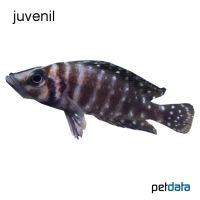Pearl Lamprologus (Altolamprologus calvus)
| Pearl Lamprologus Altolamprologus calvus | |
|---|---|
| Name | Pearl Lamprologus |
| Name Lat. | Altolamprologus calvus |
| Synonym | Lamprologus calvus |
| Family | Cichlids |
| Family lat. | Cichlidae |
| Order | Cichlids |
| Order lat. | Cichliformes |
| Origin | Lake Tanganyika |
| Habitat | Rocky habitat |
| Diet | Carnivore |
| pH | 7.5-9.0 |
| Behavior | Semi-aggressive |
| Keeping | Individual, pair |
| Care Level | Moderate |
| Reproduction | Cave spawner |
| Breeding | Moderately difficult |
| Life Span | 6-8 years |
| Protection | No |
| Metric Units | |
| Size | 12-14 cm |
| Temperature | 24-28 °C |
| Hardness | 15-18 °dH |
| Aquarium | ~ 200 l |
| US Units | |
| Size | 4.7"-5.5" |
| Temperature | 75-82 °F |
| Hardness | 267-320 ppm |
| Aquarium | ~ 50 gal |
Distribution and habitat
The guinea fowl cichlids are found exclusively (endemically) in Lake Tanganyika, where they are widespread along the southern coast. They live in near shore rock and scree zones between stones and over free sandy areas in 3-25 m depth. Some site variants are known, which differ in their coloration.
Maintenance
The aquarium setup should have rocky structures that reach the water surface, with plenty of crevices, caves and shelters to provide hiding places, as well as sturdy plants and some open sandy areas
There should be no detectable ammonia, ammonium or nitrite, and the nitrate level should not exceed 100 mg/l. To ensure the water quality and oxygen content, a filter and heater adapted to the aquarium size is required, as well as lighting for the species-appropriate day-night rhythm of the animals.
Diet
In the wild they feed mainly on shrimp and small crustaceans and small fish. The food supply consists of live, frozen and dry food. For a balanced diet, feed once a day with a high-quality dry food for Tanganyika cichlids (flakes, granules, pellets) as well as daphnia, artemia, mysis, shrimp and mosquito larvae (live or frozen). It is recommended to feed small portions several times a day. Only feed as much as will be eaten within a few minutes. A regular and varied diet promotes health and prevents deficiency symptoms.
Behaviour and compatibility
This relatively peaceful and quiet species should be kept singly or better in pairs. However, they defend their cave including the immediate surroundings vehemently. Keeping several animals is only recommended in a much larger and richly structured tank. They can be socialized well with other, not too small, Lake Tanganyika cichlids
Basically, only compatible fish species with similar demands on water condition and water temperature should be socialized.
Sex dimorphism
In the larger males, the ventral fins are longer and the dorsal and anal fins are more pointedly extended than in the smaller females.
Reproduction and breeding
They are pair-building cave breeders. The female spawns up to 200 eggs in a cave, a narrow crevice or in an empty snail shell into which she barely fits. The male guards the territory while the female looks after the brood. After 2-3 days the fry hatch and swim free after about 10 days. They are guarded for a short time before the brood care ends. The fry grow very slowly.
Fry must be fed several times a day with special rearing food (e.g. Artemia nauplii). In community tanks breeding is hardly possible, because the fry are easy prey.
Important
Their flat physique allows them to forage in narrow crevices (shrimp, crabs, fish spawn) and also to retreat in a flash from enemies into narrow crevices.
Different site varieties should not be maintained together, as they may interbreed. The guinea fowl cichlids (Altolamprologus calvus) can be confused with the Nander cichlids (Altolamprologus compressiceps), but they have a shorter, taller build and are scaled on the top of the head
The well-being of the fish should be monitored regularly. Temperature should be checked daily, pH, hardness and nitrate levels at least every 14 days. Regular partial water changes are recommended, even if the contaminant level has not yet reached the upper limit. Sudden changes in water quality should be avoided. Newly introduced fish must be accustomed slowly to the water in the aquarium.
Further literature can be found in your pet store.
References
Text: Werner Winter; Image: petdata
Source: BMELV (1998): Tierschutzgutachten - Haltung von Zierfischen (Süßwasser); BAENSCH & RIEHL(2004): Aquarien Atlas Bd. 2, Mergus Verlag; ENGELMANN (2005): Zootierhaltung - Tiere in menschlicher Obhut: Fische, Verlag Harri Deutsch
- Gemäß § 21 Abs. 5 Tierschutzgesetz idgF
